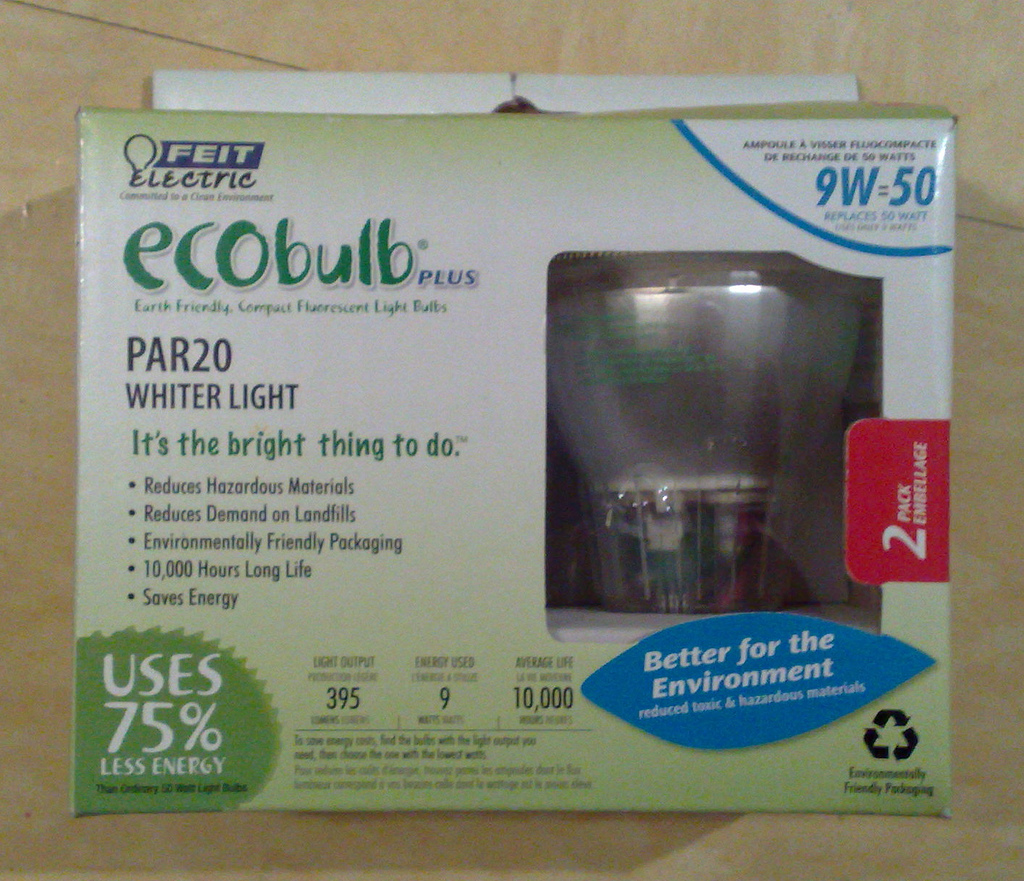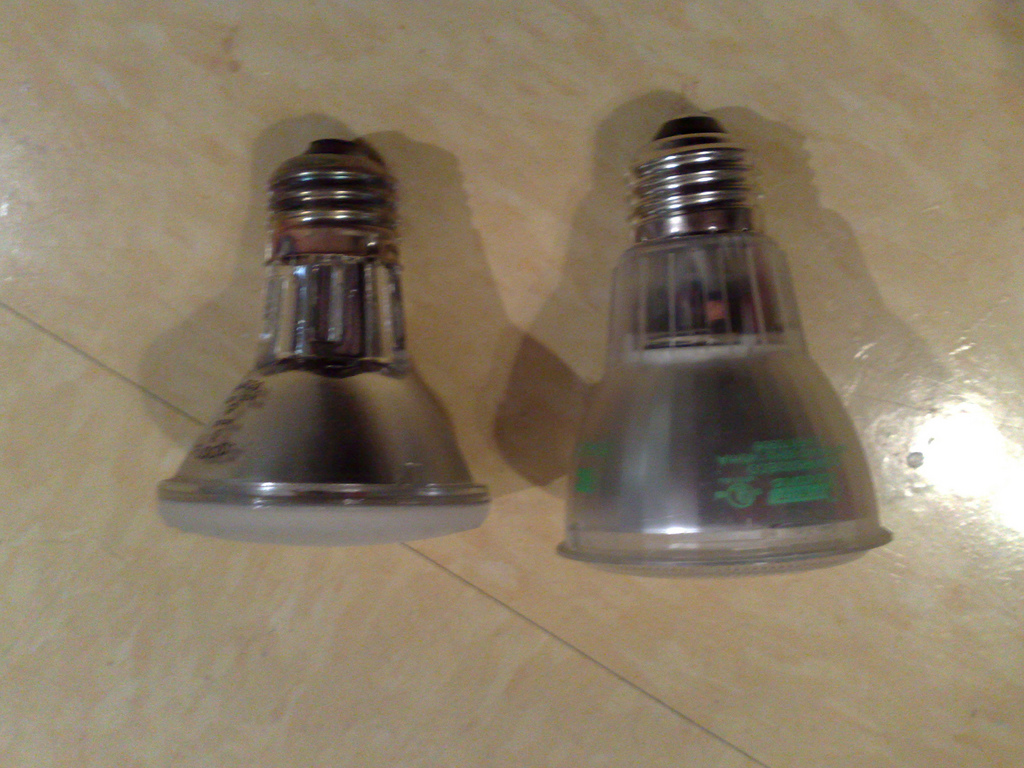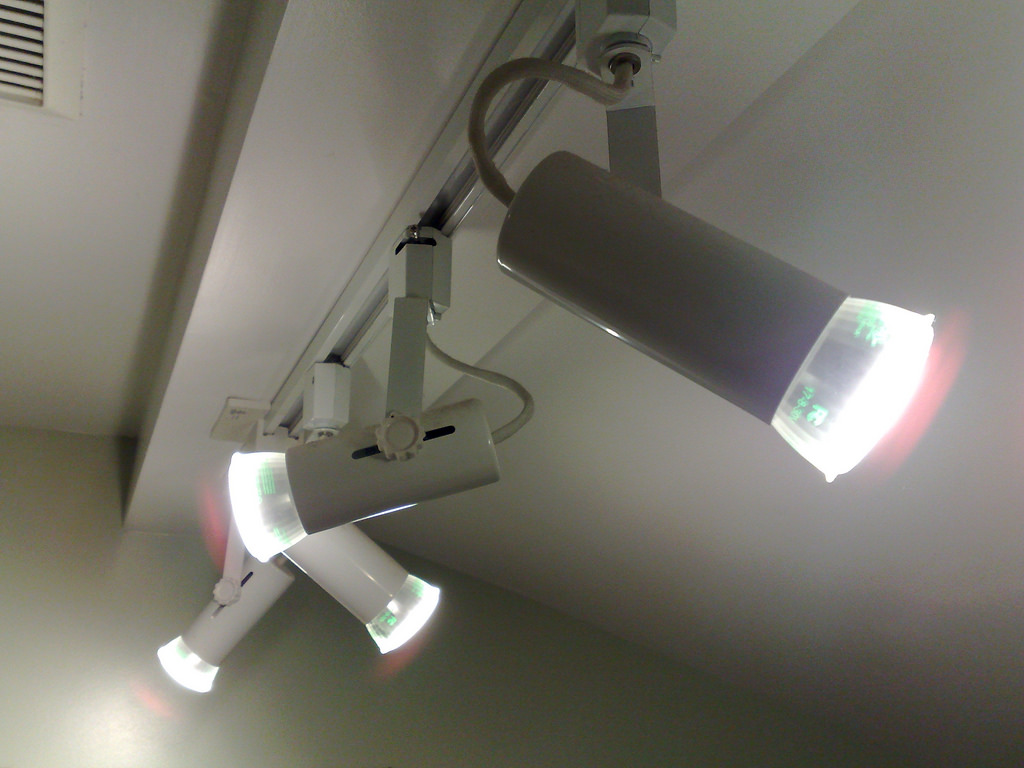Our house at 100 Prince Street has two rooms, the upstairs bath and the downstairs kitchen, that are lit with halogen light bulbs on tracks. Each track holds four 50 watt bulbs. The bulbs are hot, burn out a lot, and are expensive to replace ($17 for a package of three).
I’d always been under the impression that there was something special about the whole halogen-lighting setup, and that these were bulbs we couldn’t replace unless we replaced the fixtures; a helpful clerk at Canadian Tire disabused me of this notion this afternoon, telling me and another guy with the same issue that although a compact fluorescent replacement might stick out a little more, there’s no problem with swapping out halogen and replacing them.
And so I bought two packages of two 9 watt ECObulbPLUS compact fluorescent bulbs to retrofit the bulbs in the upstairs bath — three of them burnt out over the last week anyway, so it was high time.

The new bulbs were just a little longer than the ones they replace, but because the fixtures aren’t the kind where the bulbs are flush, this didn’t matter at all.

The light is only slightly less “warm feeling” than the halogens, and not at all like the “fluorescent-lit 1975 high school history classroom in the middle of winter”-light I assumed I might be ending up with:

I replaced 200 watts of bulbs with 36 watts of bulbs. Assuming we have the bathroom lights on for 2 hours a day, or 730 hours a year, that would mean that, before the change, we were using 146 kilowatt hours to light the bathroom every year, for a cost, at the Maritime Electric rate of 15.15 cents/kwh, of $22.11 per year.
After swapping in the new bulbs we’ll use 26.28 kwh/year for a cost of $3.98/year. The bulbs were on sale for $10 per package, so the $20 total cost will be paid for in the first year of the bulbs 9-year rated lifespan.
Next stop: the kitchen. There are six of the 50 watt halogen bulbs there that need replacing, and the Canadian Tire sale is still on.
 I am
I am
Comments
Only downside with these
Only downside with these bulbs is that they are not dimmable. Despite replacing almost all lights both inside and outside my house with CFL equivalents, I had started with regular CFLs in the twelve potlights of my basement rec room/home theatre, but ended up replacing them all with 50 watt Par 20 halogens, because I found that the dimming feature was (at least for me) essential.
There are comparable Par 20 dimmable CFL’s but they run around $20 each, compared with $9.98 for a package of two Par 20 halogens (regular price at Home Depot). Canadian Tire has dimmable R30’s, which would work in my situation, for only $9.99 each. All these bulbs say that that they don’t work with ‘electronic dimmers such as the Lutron
What a good idea. I hate
What a good idea. I hate track lighting, but someone installed some in our house anyway before we bought it. I think we’ll do the same. Up until now my strategy has been to turn them off every time someone turned them on.
You’re replacing 50 Watt
You’re replacing 50 Watt halogens, which typically put out 900 units of illumination (says this source). But the compact fluorescents you bought to replace them each output less than half of that, by the 395 unit spec on the box in your photograph. It seems the Watt Equivalence spec assumes you’re replacing normal incandescents, but halogens are brighter, meaning more illumination per watt. They’re kind of a hybrid between incandescent and fluorescent, I think, in that the bulbs contain something like the same gas that’s in a fluorescent bulb, which gives them more glow from the tungsten. Better to look that up than to trust me on that though.
But then this 50 Watt halogen
But then this 50 Watt halogen is only 570 lumens, it’s package says.
“its” I mean
“its” I mean
That “hybrid” explanation of
That “hybrid” explanation of mine is wrongheaded. I think Wikipedia has it right, explaining that the extra gas in a halogen bulb is to stabilize the tungsten, so the filament can be run hotter and brighter without evaporating.
lez do it
lez do it
Add new comment